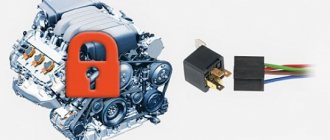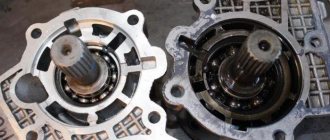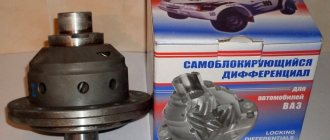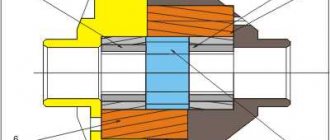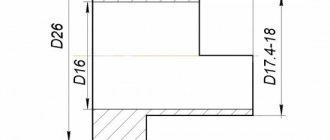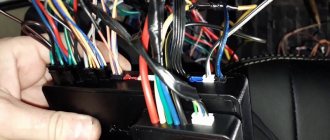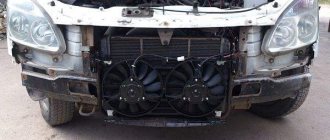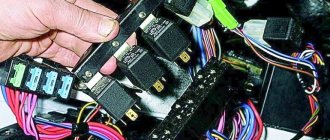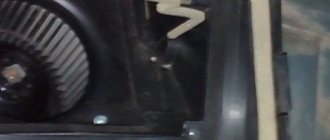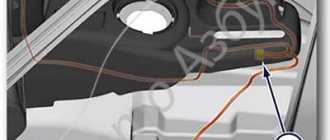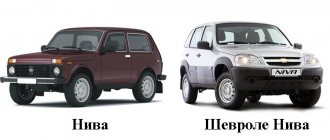We continue scientifically educational topics on the operation of a Chevrolet Niva car. In the last topic we learned how to properly use rubber ink, in this topic we will look at the most important secret of the Chevrolet Niva, How to turn on the RK correctly. The first secret is to listen less to Nivavadov, yes yes Nivavadov, because there is no other way to characterize such people, it’s interesting even if a person, as he often claims, has been driving in the fields for 20 years and talks about strange manipulations with the steering wheel and other things when turning on the center differential, forward, backward, etc. Honestly? a song by a 13 year old boy who found a strange videotape and his parents were not at home. Let's figure out how to do the right thing: Open a wonderful little book like this -
find page 36
Where it is written and even drawn (Blocking and unlocking the center differential in the transfer case is carried out by switching lever 1 to the appropriate position, see the section “Moving the vehicle” (page 49).) we go further.
There are also a lot of books, but if you read everything carefully, you will find the answer, if of course you don’t read it, then you can go to topics like this, where I’ll tell you about the boy and the videotape. And now I’ll explain to those who didn’t understand: Switching the RK diff is carried out on the go! and when pressing the clutch. The so-called torque decay!, due to this, rapid switching on and off occurs. And yes, this Lever does not connect the Front Axle of the Christmas tree, Niva PP. Of course, as without Video in our time, dedicated to all lazy Video lovers.
Guys, honestly, listen less to Nivavadav, otherwise then fairy tales appear about stopping with the steering wheel here, with the steering wheel here, back and forth. Suddenly, then it turns out that the Diff rk on the Shnivy doesn’t turn on well, of course, why shouldn’t it turn on badly if they try to turn it on in one place. Feel free to use the manual; it was written for these purposes. To the question, why are you going crazy? yes I'm going crazy)
Recently, SUVs and crossovers with all-wheel drive have become very popular. If previously preference was given only to cars with high ground clearance, now the presence of a 4x4 transmission is a priority.
But such technology can be implemented in completely different ways; let’s look at the structural features of the center lock and clutch on a Chevrolet Niva car.
Rules for using the cross-wheel differential device lock on a Chevrolet Niva
There are several mandatory rules that should be taken into account when locking the cross-axle differential.
The first rule is related to the specifics of switching the transfer case to lower gears. It is performed by the driver using the appropriate lever only when the vehicle is completely stopped.
The second rule considers the moment when the differential device locking mechanism is activated. Activation is possible when the car is driving without stopping.
The third rule explains how to correctly downshift. This can be done without stopping the Chevrolet Niva.
The fourth rule explains how to ensure optimal functioning of the cross-wheel differential device. The driver of a Chevrolet Niva SUV must periodically make switching movements with the corresponding lever with a short handle on the transfer case. This rule is especially relevant during cold weather in winter. Although experts recommend using the differential lock at least once a week.
Chevrolet > Niva
Viscous couplings, Haldex and other mechanical and electronic automatic systems that independently connect all-wheel drive and lock differentials are no longer uncommon in transmissions of all-wheel drive vehicles. Nevertheless, on many all-terrain vehicles, manual control of inter-axle (and on some inter-wheel) differential locks remains. And the transition between the rows of the transfer case is certainly “manual”.
Types of differentials
Depending on the type of gears used, the differential can be:
The cylindrical mechanism is mainly installed on cars with all-wheel drive. This is where the differential lock on the Niva would come in handy.
A bevel differential, usually symmetrical, is placed between the wheel drives.
Worm torque transmission is quieter than its analogues, but has a more complex design. It is a universal option, since it can simultaneously be an inter-wheel and inter-axle differential.
Also, the differential can be symmetrical or asymmetrical, depending on the number of teeth.
Off-road vehicles GAZ
In this category, it is worth noting the unusual model under the symbol 2330, known as the “Tiger”. The car is an armored military SUV, which is designed to transport personnel and cargo. The vehicle is equipped with a universal platform designed to accommodate various types of weapons and special equipment. During serial production, about two dozen variations of this car were created.
The Tiger all-terrain vehicle has a number of features, namely:
- The model of the “6-A” series has eliminated all the shortcomings of its predecessors. In particular, the protection class has been increased.
- An additional compartment with a closed awning is equipped.
- The equipment still has four doors and all the advantages of the prototype.
In terms of civilian characteristics, the SUV in question is a twin “pickup” with a reliable high-power unit and excellent cross-country ability. In terms of safety, the vehicle received protection from fire from a distance of 5-10 meters (from a 7.62 mm rifle cartridge and incendiary analogues of the M-948, which have an armor-piercing core).
The all-terrain GAZ vehicle in question can accommodate up to nine personnel and is initially aimed at transporting commanders in combat zones. According to Russian standards, the armor protection category of an SUV is the highest category “6-A”.
In the shortened version, the crew was reduced to four people, but there was a block of additional shock absorbers, comfortable seats with footrests and enhanced protection against mine activation. This made it possible to increase the protection parameter to six kilograms under the wheels and 3 kg. in the bottom area.
Design Features
Rice. 5.5. Transfer case:
- driven gear;
- differential bearings;
- spring washer;
- retaining ring;
- differential lock clutch;
- differential housing ring gear;
- gear ring of the front axle drive shaft;
- front axle drive shaft bearing;
- oil deflector;
- mud deflector;
- front axle drive shaft;
- flange;
- stuffing box;
- oil drain plug;
- speedometer driven gear;
- speedometer drive gear;
- hole plug for filling and checking the oil level;
- transfer case front cover;
- intermediate shaft roller bearing;
- transfer case suspension bracket;
- drive shaft bearing cover;
- bearing thrust ring;
- drive shaft bearings;
- overdrive gear;
- gear shift hub;
- gear shift clutch;
- transfer case housing;
- reduction gear;
- low gear bushing;
- drive shaft;
- back cover;
- intermediate shaft ball bearing;
- intermediate shaft;
- differential housing;
- rear axle drive gear thrust washer;
- rear axle drive shaft bearing;
- rear axle drive gear;
- satellite;
- satellite axis;
- pinion axle retaining ring;
- transfer case suspension axis;
- spring washer;
- front axle drive gear
Rice. 5.6. Transfer case drive:
- differential lock clutch fork;
- differential lock clutch;
- fork retaining bolt;
- rod protective cover;
- lever spring;
- differential lock fork rod
- front axle drive housing cover;
- lock washer;
- lever axis bushing;
- lever axis;
- differential lock lever;
- shift fork rod;
- control lever fork;
- control lever;
- differential lock lever rod;
- gear shift clutch;
- gear shift fork;
- spacer sleeve;
- retainer ball;
- retainer spring bushing;
- retainer spring;
- differential lock warning lamp switch;
- control lever fork axis;
- fork mounting bolt
The transfer case is designed to vary the torque in magnitude and distribute it between the front and rear drive axles. The car is equipped with a two-speed transfer case with a center differential lock. The transfer case is controlled (selecting a higher or lower gear, turning on/off the differential lock) with one lever through a mechanical lever drive.
Which is better to install a self-locking differential on the Niva?
A domestic SUV can be equipped with an electronic, combined, mechanical or pneumatic self-block. The first type model has a significant advantage over other versions. To activate it, you just need to press a button. The mechanism operates automatically, but only if the car is moving at a speed that is less than the threshold. The system shuts down when it reaches a mode higher than the nominal parameter.
The pneumatic version is a device mounted on both axles. The advantages of the mechanism include its compact size; the operating principle is based on the use of a pneumatic system. Self-block mechanical type is the cheapest and simplest in design. Reliability and operational efficiency depend on two semi-axial and a pair of spacer couplings, as well as pins and springs.
Forced locking on Niva and Chevrolet Niva with pneumatic drive
- Quick activation of the locking mechanism
To lock the differential, rotation of the wheel is required - this value does not exceed 11°, which has a positive effect on the speed of activation of the locking mechanism. For locks available on the market, activation occurs after rotating the wheel by 22.5°, so the IZH-TECHNO lock is 2 times faster than its analogues in terms of activation speed.
- Full differential lock
Types of cross-wheel differential devices
The Chevrolet Niva SUV is equipped with standard cross-wheel differential devices that do not require forced blocking. But the designers foresaw this and produced several types of differentials with a built-in forced locking mechanism. They can also be installed on an SUV such as the Chevrolet Niva.
Among such differential devices, the following types are very popular today:
- With a pneumatic type connection - using compressed air (the blocking is controlled by the driver from the car interior using a silicone hose).
- With an electrical connection - using a cam mechanism (the locking is activated using electromagnets).
- With self-locking (their peculiarity is that they are not controlled by the driver).
Auto mechanics warn that the positive locking mechanism installed on the differential device can excessively exceed the loads on the axle shafts and transfer case. Because of this, failure of both the axle shafts and the transfer case is possible.
Niva Chevrolet transfer case control: device, how to turn it on and off?
The engine force, which is converted into the gearbox, is transmitted to the drive axles of the Chevrolet Niva not directly, but through the transfer case. It performs several functions:
- Distributes torque between axles, allowing them to rotate at different speeds.
- If necessary, it blocks the center differential, preventing wheel slipping.
- Allows you to change the gear ratio, increasing torque.
This key transmission element ensures high maneuverability on difficult road sections.
Advantages of forced blocking from IZH-TECHNO
What are the advantages of our forced blocking over existing analogues?
Forced locking kit
The first, important point is the ease of installation and the availability of all the necessary components for installation. The differential assembly with our lock is installed in its standard place in the axle gearbox. You do not need to somehow “finish” the gearbox or purchase additional spare parts such as claw couplings or original axle shafts. Our locking is compatible with original axle shafts. All you need to install it is a standard set of plumbing tools. No “exercises” with a welding machine and grinder.
Our locking system consists entirely of original components produced by IZH-TECHNO. Therefore, we guarantee the high quality of its individual components and locking elements; In turn, the high quality of components is a guarantee that you will not need any spare parts throughout the entire service life of the product, because there is simply nothing to break in it.
We paid special attention to such a parameter as the strength of the satellite group. This is no coincidence: after all, it is she who transmits torque to both wheels of the axle and experiences the highest loads.
The strength of the satellite group is confirmed by a series of tests carried out both in laboratory conditions and in real off-road conditions.
The lock has four satellites instead of the standard two
The blocking has four satellites, instead of the standard two. This design allows for even distribution of torque and is more reliable than stock
We paid special attention to the parameters of the satellites themselves, increasing the thickness and height of the splines (see photo below):
On the left is a stock satellite, on the right is a satellite produced by IZH-TECHNO
Protection of the pneumatic drive of forced blocking. The pneumatic drive is hidden inside the axle housing and is protected from mechanical influences; it cannot be broken or damaged.
The differential housing is manufactured with high precision and strict tolerances, which ensures the absence of vibrations and noise in the axles when driving on the highway.
Niva differential housing cover
Fast locking. By increasing the number of teeth involved in the differential locking, we achieved quick response of the locking mechanism. You don't have to wait for the wheel to rotate to 120 degrees for the system to finally work. In our case, 9 degrees will be enough.
Versatility. The lock is suitable for all modifications and variants of Niva and Chevrolet Niva cars; it can be installed in both the rear and front axles, in both steel and aluminum front axle gearboxes. Locking options for 22 and 24 splines are available.
Read more about the features of forced blocking on Niva and Chevrolet Niva in the description on our website.
Types of blocking
If you want to install a locking mechanism on a differential, you should know that there are two types:
- full blocking;
- partial blocking.
Full blocking mechanisms can operate manually (forced differential locking on the Niva) or automatic mode, while partial blocking is carried out only automatically. Just don’t forget that driving a car with a full lock on a good road leads to premature tire wear. In addition, some parts also fail quickly.
Thus, the whole choice comes down to which mechanism to choose: manual or automatic. The manual system has one advantage - the driver himself decides whether to engage the differential lock or not. However, there are also a number of disadvantages:
- to activate the system, you need to remove your hand from the steering wheel;
- It is imperative to disable the lock in a timely manner, otherwise the chassis of the vehicle may be damaged;
- high price.
The automatic differential lock on the Niva has its own characteristics, among which is the need to customize it to the individual driving style of the car owner. At the same time, the mechanism does not load the car’s transmission as much as its manual counterpart. The system provides complete comfort for the driver, since, if necessary, it is activated without human intervention.
It also all depends on your driving style. For those drivers who prefer a quiet ride on a flat road surface, it is better to opt for a viscous coupling or a disc clutch. In case of extreme driving style, you cannot do without a forced differential locking system on the Niva.
Functional purpose of the device
A rigid blocking is used on the Niva to balance the incoming load. The process is based on the unevenness of the path traveled by each wheel. The sides located closest to the center travel several times shorter than the wheels located on the outer side. At low travel speeds, some of the rubber wears out faster, and at high speeds, skidding occurs.
Electronic differential locking helps to avoid the above. In good condition, it transmits torque from 1 source to 2 different consumers. In order to understand how the mechanism works, it is necessary to imagine the following: from 1 source, each consumer receives a torque of different physical parameters. If the differential lock is set correctly, the difference in the amount of torque received ensures safe rotation of the wheels along the inner and outer radius. Physical wear or mechanical damage increases the likelihood of a skid accident
When operating a VAZ 2121 on roads with unsatisfactory surface quality, the importance of the differential increases
All-wheel drive vehicles, whose axles are coordinated by a differential, distribute torque evenly to all wheels. In case of slipping, the system automatically transfers maximum torque to them. The switching process does not take much time. In the event of a malfunction, 2 wheels slip, while the other 2 remain stationary. Differential locking helps to avoid this.
It forcibly distributes torque evenly over the front axle, between it and the axles. In case of temporary slipping, the device will provide the necessary uniform force to increase the quality of traction.
Differential operating principle
On the one hand, the differential provides the driver with comfort and safety when driving a car on a hard and dry road surface. On the other hand, everything is not so simple - as soon as you go beyond its limits or get on a slippery surface, the differential makes it impossible for the car to move.
Depending on the situation, the planetary mechanism operates in one of three modes (sometimes differential locking on the Niva is not needed):
- When the car is moving in a straight line.
- When entering turns.
- The car drives through a slippery surface.
Chevrolet Niva 2006, 80 l. With. - spare parts
In contrast to the suspension, it has a very weak transmission and steering system. Categorically not designed for jerking and shock loads. This increases the load on the transfer case bearings. There is a diagram on the shift lever. To engage a downshift, you need to move the lever to the right, up. To lock the differential, pull it all the way to the left.
There are also Latin letters on the lever. So, L is a low gear, N is neutral, and H is high. Now let's find out how to use all this so that we don't have to repair the mechanism and change the transfer case bearings.
So, if you have to overcome a ford or a puddle, you should stop completely and turn on a lower set of steps. Even at 5 kilometers per hour you will have problems with the transfer case. But you can lock the differential even while driving. This won't bring any surprises.
What is it for?
Unless fuel consumption increases due to the constantly working two axles and axle shafts. In what cases is it necessary to engage a downshift on a Chevrolet Niva? Please note that it should only be enabled when absolutely necessary. Otherwise, the load on the teeth and shafts increases. Forced unlocking Sometimes it happens that the lock gets stuck - it cannot be turned off even when the car is completely stopped.
The situation is quite common for the Chevrolet Niva. To do this, engage reverse gear, accelerate a little and turn off the differential lock while driving.
But if a similar lamp continues to light on your instrument panel, as in the photo below, the lock has not been turned off.
What to do in such a situation? It is necessary to turn on the first speed and try to turn off the unit again. Moving back and forth will solve the problem of a stuck differential. In general, it is recommended to turn on the center lock only in serious off-road conditions.
At the intersection of dirt roads and sand dunes, a downshift is sufficient. Overcoming a deep puddle Often a dispute arises between motorists about how best to cross a ford with a transfer case. You may ask - how long does it take to turn on the blocking and then turn it off? There is another nuance here - very often, many owners of the Chevrolet Niva have a problem with the blocking - it does not turn off.
How to use the transfer case on a Chevrolet Niva? Video review
It just jams and that’s it, you have to drive on the highway with the blockage. This, you understand, is very harmful for the machine and in such cases you must turn it off.
There are several options - turn on reverse, accelerate a little and try to dislodge the lock while driving. You need to do this at speed; it works quite often. Moreover, you can accelerate forward and also try to turn off the lock. I also got stuck once, but even then I didn’t notice it right away and it’s not a problem.
In bright sunny weather it is sometimes difficult to see. Well, about turning off the center wheel - I managed to turn it off just when reversing.
Needless to say, now I turn it on only in the most dire cases. In the rest of the others, lower gears are quite enough for me. Just today I went to the lake to check if the ice had melted.
About the device
The transfer case is not present in all VAZ passenger cars, but only on cars with two drive axles. In the transmission, the transfer case (TC) is installed at the rear of the gearbox; a rear driveshaft is attached to its shank, which connects the transfer case to the rear axle. The front axle is also driven by the steering wheel; it is connected to the transfer case by a front driveshaft.
The reduction gear in the Republic of Kazakhstan is designed to obtain high torque, it is used to overcome difficult sections of the road, and helps to cope with off-road conditions. The VAZ Niva transfer case contains the following main parts:
- the body itself;
- front axle drive shaft;
- intermediate shaft;
- drive shaft;
- gears;
- bearings;
- differential housing;
- satellites;
- differential lock clutch;
- gear shift clutch;
- flanges (for connection to cardan shafts);
- oil seals;
- control levers.
The VAZ 2123 transfer case is installed at the rear of the gearbox and is attached with brackets to the bottom of the car. It is driven by an intermediate shaft. Torque from the drive shaft to the drive axles is transmitted by cardans, which are screwed to the flanges of the transfer case drive shafts.
The transfer case body is made of aluminum alloy. In its upper part there is a hatch with a lid.
The transfer case consists of the following parts:
- RK Corps.
- Drive shaft.
- Control levers.
- Bearings.
- Gears.
- Drive shafts (front and rear).
- Flanges.
- Differential mechanism housing.
- Axles.
- Satellites.
- Clutches for gear shifts and differential locks.
- Oil seals.
- Retaining and thrust rings.
- Housing covers.
- Breather.
The Chevy Niva transfer case has three speeds:
- The first one, with a gear ratio of 1.2.
- Neutral.
- Low (second), with a gear ratio of 2.135.
Neutral allows you to temporarily disengage the gearbox from the transmission. It is used when connecting a winch and other units to a vehicle.
The first speed is intended for on-road driving, and the second is for off-road use where high torque at low speed is required.
Despite the difference in varieties, the structure and operating principle of these boxes are the same. How does the transfer case (Niva Chevrolet) work? This node includes several elements:
- Drive shaft.
- Center differential locking mechanism.
- The differential itself.
- Chain or gear transmission.
- Drive shaft of the rear and front axle.
- Downshift.
And also interesting: Protective mesh of the air intake housing Niva 2121; 21213, 21214, 2131 cabin filter antilist 6521 – Filters
All this is controlled from the interior. There is a transfer lever for this. "Niva Chevrolet" has both locking and downshifting. The torque that goes from the main transmission to the transfer case is transmitted through the drive shaft.
- Asymmetrical (distributes torque in different ratios).
- Symmetrical (distributes forces equally).
Comparison of differential locks on Niva (VAZ 2121)
The first video review compares the cross-country ability of SUVs in deep snow. The following participants took part in the test: Niva with DAK, with DAN and without differential lock. To ensure the accuracy of the tests, all three cars had the same wheels with Bear tires.
Niva with DAK (self-locking differential)Niva without differential lockNiva with DAN (self-locking differential)
Based on the results of the races, you can notice an obvious difference between the competitors:
- Niva with DAK coped with the task.
- The Niva, without a self-locking brake, not only could not drive through deep snow, but also skidded, trying to overcome the snowdrifts along the previously left track.
- Niva with DAN passed the test best of all.
Another comparison of self-locking differentials was carried out by another group of VAZ 2121 car enthusiasts. This time the tests took place in the summer, on sand and mud.
Niva with DAK (self-locking differential)
Niva with DAN (self-locking differential)
SUVs with different “blockages” tried to climb the mountain, as a result:
- With DAK - I managed to climb the slope on the 3rd attempt.
- WITH DAN - I managed to climb the hill only on the 5th try.
Despite this, the expedition participants noticed that on the way to the test site, the Niva with DAN confidently drove under its own power, unlike many other SUVs.
During the break, they said that much still depends on the manufacturer and the gap in the design of the device. The minimum gap allows you to work more accurately; torque is transferred to the second wheel after a slight shift of the first. It also plays an important role which lock will be installed on the front wheels and which on the rear wheels.
What differential lock do you recommend for the Niva VAZ 2121? Maybe because of the high price (about 10 thousand rubles) there is no point in using it at all? Let us remind you that other important factors also influence the cross-country ability of an SUV.
Keywords: Niva safety | Niva front suspension | Niva rear suspension | Niva accessories
The Chevrolet Niva is recognized all over the world as a high-quality SUV. This is due to the high ability of this car to drive through the most off-road terrain. Such cross-country ability is ensured by the capabilities of the cross-axle differential. What is this device? How does it function on a Chevrolet Niva? Why do you need a cross-axle differential lock?
What is a differential lock?
As is already clear, when a car hits a slippery surface, one wheel loses traction and takes all the torque, which leads to the car stopping. Many drivers who fall into this trap know very well that the slipping wheel needs to regain traction. To do this, the wheel is loaded or something is placed under it. The wheels of one axle get good traction with the road surface, and the car begins to move.
In this case, it is necessary that the loaded wheels do not lose torque, which is what the differential lock actually serves. The whole point of locking the Niva's cross-axle differential comes down to uniting all the drive wheels and bringing their angular velocity to the same value.
Japan
The Land of the Rising Sun, which has been a trendsetter in off-road fashion for at least the last 50 years. Therefore, Nissan and Toyota are vying for the title of best car, with the former having two brands, and the latter having at least three cars vying for this title.
Toyota 4Runner
The first model was released in 1985. Since then, the production of this SUV has not stopped. In 2009, the 5th generation was introduced, and in 2014 it was restyled. In 2000, more than 100,000 off-road vehicles bearing the Runner name were sold.
The Limited version features a special X-REAS suspension that, combined with unique Bilstein shock absorbers, automatically adjusts when installed on 20-inch aluminum wheels. The TRD Pro Series version features all-wheel drive, a locking rear differential, and an intelligent adaptation system for various road surfaces. The most vulnerable places are protected by special plates.
To overcome severe off-road conditions, the KDSS (Kinetic Dynamic Suspension System) system is provided, which turns off the stabilizer and increases the movement of the axles. If necessary, the car can tow another car weighing more than two tons.
In terms of comfort, the buyer is offered a leather interior or seats covered with water-repellent material; it is possible to install a third row. There is 2-zone climate control, an Entune Audio Plus audio system with 15 speakers, Connected Navigation, and a transparent sunroof.
Toyota Hilux
In the rating of off-road vehicles for cross-country ability, this brand enjoys well-deserved authority among drivers and experts. It has been produced in Japan since 1968. For the North American market it was adapted and given a new name - Toyota Tacoma.
In the fall of 2015, the eighth generation was introduced with a large selection of power units. The 4.0-liter V-shaped petrol six is considered the most powerful unit of all seven power plant options. It is capable of producing 278 hp.
Constantly working to improve off-road performance, engineers do not forget about the comfort of the car. Inside there is a high-quality leather interior, the ability to start the engine without a key is provided, and an automatic air conditioner maintains the microclimate in the cabin. A wide range of functions are controlled using a 4.2-inch touch screen.
Nissan Xterra
A pickup truck manufactured in Tennessee cannot fail to be included in the off-road rating of off-road vehicles, the list of which will be expanded further. The official presentation of this car took place relatively recently - in 2005. But in fact, it is known much earlier under the name Nissan Navara, which debuted in 1986.
This car is directly related to sports, because it got its name after the brand acted as the main sponsor of triathlon competitions. The events took place in an area called Xterra.
This simple and reliable model is designed for use on roads with difficult terrain, the ground clearance reaches 23 cm. Initially, minimal attention was paid to comfort. But the latest trim levels include power accessories, cruise control, a Rockford Fosgate audio system, a multifunction steering wheel, Bluetooth communication, heated seats and much more. The SUV was built on a cargo platform, so it cannot always drive through narrow streets.
Nissan Frontier PRO-4X
In 2016, the mid-size pickup truck received the honorary title of winner in the “Best Compact Pickup Truck” category according to the Autopacific brand.
Along with a manual transmission, all Nissan Frontier cars are equipped with an automatic transmission. This approach allows women to operate this car on an equal basis with men. For better cross-country ability, a rear differential locking system is installed. Roomy, with high ground clearance, it can take a large amount of cargo and allows passengers to sit comfortably. If you need to spend the night in an open area, the body is specially designed to accommodate an overnight tent. Under the hood there is a 4-liter V-6 with a capacity of 300 hp.
The SUV is exported to Australia, New Zealand, Argentina and Mexico. He is a member of the Ultimate Factory, where he often takes honorable prizes.
Varieties
The design of the car provides for the presence of a transfer case, similar to the unit that is installed on the VAZ 2121. In this case, the so-called small-module RK with single-row or double-row bearings are used.
About 1000 copies of the Chevrolet Niva modification FAM-1. They were equipped with gearboxes from Suzuki Grand Vitara combined with a transfer case.
There are several types of these elements:
- Equipped with coaxial drive shafts. This type is used on many SUVs. It gained such popularity due to the use of a single main gear for both axles.
- With a misaligned driven shaft. There is no intermediate shaft here. The advantages of this system are high efficiency and noiselessness. Also, this box has a low curb weight.
- With drive axle drive blocking. It is also installed on the Chevrolet Niva. Here it is possible to use all the torque without slipping the wheels, which is very important when driving off-road. The front axle engages only on difficult sections of the road. On asphalt surfaces, the SUV has a single-wheel drive (only the rear axle works). This allows you to reduce fuel consumption and, if necessary, increase cross-country ability (when the drive “closes”). There is also an interaxle forced locking.
Also interesting: Construction and repair of the VAZ 2121 Niva transfer case
How to determine whether the differential lock is engaged on a Chevrolet Niva
You can determine whether the inter-wheel differential device is locked without even leaving the Chevrolet Niva interior. Let's look at how to do this:
- Find two control levers between the passenger and driver's seats:
- gear shift lever (with long handle);
- machine transfer case control lever (with short handle);
- move the transfer case control lever forward - this will engage a lower gear to the drive axles of the wheels from the gearbox.
- Move the transfer case control lever back - this will disengage the downshift.
- Move the transfer case control lever left and right. This will switch the blocking of cross-wheel differential devices:
- to the left - switch on;
- to the right - shutdown.
As you can see, with the transfer case control lever you can not only change gear levels, but also control the process of blocking the cross-wheel differential device. This is due to the fact that the car differential lock is part of the functioning of the all-wheel drive mechanism of the Chevrolet Niva. The locking switched on at the right moment facilitates the unhindered movement of the SUV in difficult road conditions.
Niva is a car that has been produced since 1977. It differs from other domestic cars in that it has permanent all-wheel drive. Few car enthusiasts know what this means, although they have heard a lot about this feature of the vehicle; a diagram of the device can easily be found on the Internet. All-wheel drive in the Niva is equipped for all 4 wheels, and the center differential is locked. The mechanism consists of a gearbox, a transfer case designed for 2 stages, and cardan shafts located in the front and rear of the machine. This also includes the front and rear axles.
When the engine starts to rotate, an impulse is sent to the gearbox and transfer case, after which the torque is distributed to the front and rear axles simultaneously. Afterwards, the gearboxes are activated, and behind them the front and rear wheels of the Niva begin to rotate. Torque causes 4 wheels to rotate at once, which is why it is called full torque. But the rear wheels still drive.
Differential blocking of Niva Chevrolet
Since the Chevrolet Niva is an SUV, it needs the ability to enable blocking of all cross-wheel differential devices. This is caused by the need to increase the vehicle's cross-country ability in off-road conditions.
Let's consider the mechanism for blocking the differential device on the Chevrolet Niva:
- if one of the wheels slips, the cross-axle differential will transfer traction force to it from the internal combustion engine;
- the remaining wheels are at rest at this moment, because the traction force will not act on them;
- the vehicle will stop.
Forced blocking of the cross-axle differential is necessary in order to make maximum use of the traction transmitted from the car engine to the drive wheels. Thanks to the action of the components of the differential (these are gears, shafts and a locking clutch), a rigid connection will occur between the drive wheels. That is why the torque will be evenly distributed between both vehicle axles - front and rear. Thus, the cross-country ability of the Chevrolet Niva SUV will increase.
How to enable differential lock on Niva
- carburization - diffusion saturation of the surface layer of steel with carbon in order to increase hardness and wear resistance;
- heat treatment, in accordance with GOST standards for materials, in order to obtain the properties of the part necessary for the stated operating conditions;
- grinding;
A distinctive feature of electric locking differentials is their ease of installation, ease of connection and simplicity of the unit itself. Air-locking differentials and hydraulic locking differentials require complex installation. They include many components, which significantly reduces the reliability of the unit, and poor installation leads to damage to the wiring and failure of the entire system as a whole.
When installing differentials with electric locking, there are no unnecessary installation diagrams where mistakes can be made: there is no need for compressors or cylinders to turn on pneumatic and hydraulic drives. Electrical locking, when the control button is pressed, is carried out by an electromagnet and the electrical circuit activates the locking mechanism.
The 100% locking differential has been proven on millions of off-road vehicles around the world. Developed in accordance with Russian climatic and road operating conditions, the Autogur73 differential:
- allows you to completely lock the axle shafts at the driver's request
- can be controlled by hand switch
- Quadruple design provides maximum strength
- maintenance-free, no special lubricants or additives required
- Compatible for use on front or rear axles
- in off mode it functions as an open differential
The Niva and its various modifications allow you to operate 3 differentials at once. Thanks to this factor, the vehicle’s cross-country ability increases significantly when driving in rural areas. The forced locking format involves connecting the driving wheels together, causing them to spin at different speeds. This approach allows you to use the maximum possible traction characteristics of the engine, which are transmitted to the wheels.
To lock the differential on the Niva, the manufacturer has provided a clutch for the locker. When forced locking is turned on, the wheels become interconnected and rotate in the same mode. When the inter-axle lock is activated, the axles located at the front and rear interact and distribute traction to all wheels. This mechanism is easy to use, which is confirmed by the unique cross-country ability of the Chevrolet Niva.
Turning on all-wheel drive.
The use of blocking will be justified in the following cases:
- If there is a possibility of wheel slipping, in areas with poor surface conditions,
- If there is a lack of engine thrust at high speeds,
- When driving on roads with loose surfaces, snow, ice.
You should also take into account some features of the Chevrolet Niva, namely, the helplessness of the transmission when hanging diagonally. In this mode, the wheels begin to spin, so if necessary, you need to dig under the wheel or make an embankment under the raised axle.
Many car enthusiasts like SUVs due to their high maneuverability in difficult terrain. Among domestic cars, a striking example is the Chevrolet Niva brand. And in order for the car to be able to overcome hard-to-reach obstacles, you cannot do without differential locking on the Niva. Regardless of the brand of SUV, including the aforementioned Niva, all cars have one characteristic feature, which is the presence of all-wheel drive and differential. More detailed information is provided below.
Chevrolet Niva expedition › Logbook › * Self-locking differential in the bridge.
Friends, I want to share with you my short report on the operation of a self-locking differential. I would like to warn you right away that this is my personal opinion, which was formed after two years of using such devices.
We will talk about a screw differential lock. In pursuit of the cross-country ability of my former field, I began to build self-blocks into the bridges. After the sale of the Niva, the megadevices migrated to the Chevy, but were later dismantled. The devices are of course very interesting and really help to increase the vehicle’s cross-country ability. The truth is not as much as you might expect. Let's just say that self-locking locks help you get stuck further than a standard differential. Sometimes automatic locking even gets in the way, especially on the front axle. This usually happens in slush or snow, when you need to turn onto a slope. The car stubbornly rows along the trajectory that it likes best, which does not always coincide with the driver’s opinion. Another minus of self-blocks, even if only in the rear axle, is that in order for it to work as expected, frequent maintenance is necessary. In my experience of operating a Chevy in almost civilian mode, about once a quarter it is necessary to remove the lock to tighten the trigger moment. After half a year it doesn't hold up at all. This happens because the device is built on the basis of friction, and what rubs tends to wear off. If you do nothing after the preload weakens, then nothing bad and nothing good happens. The dissolved self-block begins to work like a regular differential, and simply becomes a “pill for the placebo effect.” It is also worth noting that with a fully working self-block, you need to very carefully gas on any heterogeneous surface, including snow and slurry. Especially on large wheels with pronounced tread. It is very easy to collapse the axle shaft in this situation.
To check the operation of a self-locking differential, it is enough to simulate diagonal hanging. Raise the axle under the axle/lever with a jack and try to move out of such a “trap”. If the self-block does not work (requires re-tensioning), then those wheels that are raised in the air will spin, completely simulating the operation of the most ordinary differential. But I did not suggest this to you, and if you follow this method of verification, you rely entirely on your own peril and risk.
For myself, I came to the conclusion that the best blocking is a forced one, which can be turned off; then it interferes or is simply not needed. And the self-locking differential is too “sporty” and requires a lot of attention to maintain. Therefore, after the last weakening of the preload, I decided that this was not suitable for me.
Thank you all for your attention
Transfer case alignment
Correct installation of the transfer case can be done in several ways. Most often in auto repair shops, repairmen use the following method:
- hang the car on a lift;
- loosen the transfer case;
- start the engine;
- engage the gear and accelerate the car according to the speedometer to the speed at which vibration occurs (often it occurs at speeds from 40 to 80 km/h);
- without using the brakes, reduce the engine speed, then turn off the ignition.
The transfer case itself is centered in place, all that remains is to tighten the fastenings of the supports.
You can also adjust the position of the RC using a wire; we do it as follows:
- loosen all four fastenings of the transfer case supports;
- fasten one end of the wire to the rubber coupling of the propeller shaft;
- we attach another piece of wire to the CV joint, bring the other ends of the wire to each other;
- rotate the shaft; if the transfer case is not centered, the ends of the wire will diverge during rotation;
- the task comes down to installing the transfer case using the selection method so that the ends of the wire practically do not diverge from each other in any position when turning the shaft.
Device
The military line of GAZ all-terrain vehicles "Tiger" is a military analogue that has at least the third category of ballistic protection in the area of the stern, sides and frontal part. The roof of the vehicle is equipped with a large hatch with a pair of flaps and a rotating lid. In addition, this mechanism provides mounts for various types of weapons. Opening armored glass allows the use of machine guns and pistols.
The main cabin of this “M” class modification has six seats, as well as a compartment for accommodating a grenade launcher shooter and storing the corresponding ammunition. In addition - communications equipment, radio blocking devices, location devices.
Transmission of Chevrolet Niva and Lada 4x4: what is the difference
The first thing that catches the eye of the average user is that the Lada’s transmission is controlled by two levers, while the Chevrolet Niva has only one, not counting the gearbox control lever. This is due to the fact that Chevrolet’s upshift and downshift ranges, as well as the center differential lock, are implemented using a single-lever design. In addition, the Niva's front axle gearbox is not attached directly to the engine cylinder block, and the transfer case has three mounting points, unlike the Lada, which has two.
Downshift.
Used to temporarily increase torque. This is necessary to reduce the rotation speed of the wheels, but give them more force. Forced downshifting is advisable on off-road conditions, when this mode eliminates slipping by distributing more force between the axles.
After turning on this mode, the torque mode is transmitted from the transmission to the drive shaft. Then it is redistributed using the center differential. There was no locking mechanism in Niva cars (VAZ 2121). In the Chevrolet Niva, it is possible to force the teeth to lock.
The transfer case allows you to operate the Chevrolet Niva in five operating modes:
- neutral position
- torque transmission in a 1:2 ratio by unlocking the differential and disabling low gear
- automatic torque distribution, for example when driving on asphalt roads. Turns on in modes with a locked differential and upshift.
- Downshift combination with lock off. Provides 1:2 ratios
- Full differential lock when low gear is engaged. This type of operation ensures rigid blocking of the axles, including the axle shafts. In this case, the torque is transmitted unevenly and allows the car to adapt to different road conditions. This mode allows you to use the car as efficiently as possible to achieve the best cross-country ability.
Using a handout
The switch pattern is printed on the lever. According to the instructions, to turn on the lowering, you need to move the lever all the way to the right and up. To lock, the lever is moved all the way to the left. There are also letter designations on the handle:
- L(low) – reduced
- N(neutral) – neutral
- H(high) – increased
Proper use of the transfer case allows you to avoid increased loads and breakdowns. You must also remember that when the differential is locked, fuel consumption increases, so you should use this mode only when necessary. Switching, as well as locking, can be used while driving.
Engaging a downshift is important when driving on a long climb or overcoming a ford. Enabling this mode on an asphalt road at high speed results in excessive load on the teeth and shafts.
Sometimes a forced unlock is necessary. Situations arise when the lock cannot be disabled even when the car is completely stopped.
The status can be seen by the icon on the dashboard. If the lock is jammed, you must engage first gear and turn off the unit. If this does not help, you need to move back and forth.
How do you turn the lock on and off?
The lever has several positions
: (connection diagram)
- central location of the lever - “neutral” is turned on, even when the gearbox is turned on, the car will not be able to drive, because the connection to the wheels is disconnected;
- moving the lever forward - the lowering switch is activated;
- switching in the opposite direction - correspondingly turning off the downshift;
- the transfer case lever is moved to the left - the center differential lock is ON;
- the lever is moved to the right - the lock is OFF.
- (I-Н) – differential is unlocked, reduction is turned off. This is a mode for everyday driving.
- (III-L) – the differential is disabled, low gear is in operation.
- (IV) – reduction is disabled, the differential is locked. In this case, all wheels of the vehicle rotate at the same speed.
- (VI) – the differential is locked, the reduction gear is in the on state.
To engage the differential lock on the Niva, you must press the clutch and move the transfer case lever to the left. To disable the lock, move to the right side (away from you).
Why the lock may not turn off
A common problem with the center differential on the VAZ-2123 is the locking lever souring.
Since the adjustment unit is located under the bottom of the car, it is susceptible to corrosion and sand deposits in moving joints.
It is necessary to clean the assembly from dirt and rinse it several times with WD-40. After this, you can try to disengage the jammed lock by forcefully switching the lever when you start moving the car in reverse or forward.
Advice! To avoid frequent jamming of the differential lock, it is recommended to periodically turn it on once every 6-8 days.
Why might the blocking not turn on?
The main cause of the problem is that the locking clutch in the transfer case does not engage the corresponding ring gear (the grooves and teeth do not match). In this case, it is advisable to try to engage the lock by gently and continuously pressing the transfer case lever while the car is moving.
In this case, it is necessary to constantly slightly steer the car in different directions (rocking the steering wheel) to create conditions for the differential to operate and the ring gear to coincide (engage).
Transfer case malfunctions
The transfer case is a complex unit, so it is important to correctly diagnose the malfunction and be able to quickly fix it. The most common sign of its incorrect operation is increased vibration.
If it is observed when driving in various modes, then the cause may be wear of the elastic coupling. A visual inspection will help verify this. Vibration under direct load (acceleration) indicates a loose attachment of the transfer case to the body, a faulty CV joint on the intermediate shaft, or a jammed joint on one of the cardan shafts. If vibration is observed at a constant speed, then there is a problem with the balancing of the cardan shafts themselves or the differential.
Malfunctions often occur due to difficulty switching modes
Here attention should be paid to the hinges of the control mechanism, as they usually become clogged with dirt. The fork or stem may be deformed
Over time, nicks appear on the splines of hubs and gears. They can be easily removed by grinding, but to identify the defect you have to remove and disassemble the entire assembly.
Preventive maintenance includes timely replacement of transmission lubricant. It is performed every 45,000 km
It is important to follow the rules for switching modes during operation, and also carefully monitor the timely unlocking of the differential
